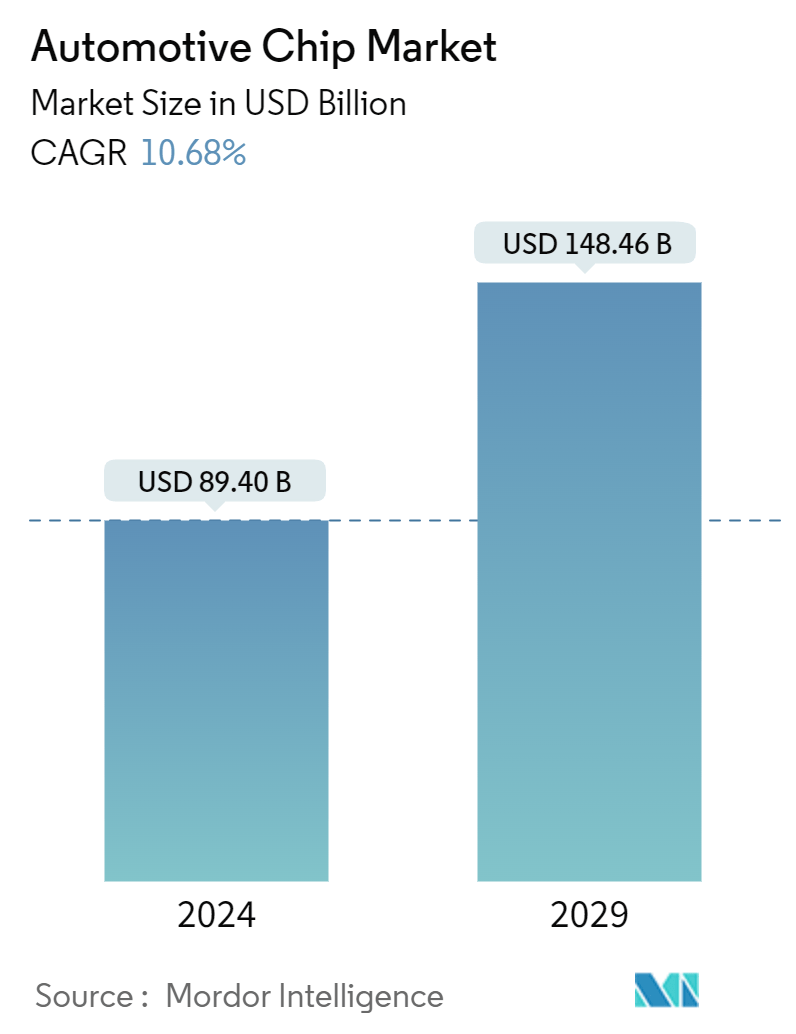Market Size of Automotive Chip Industry

| Study Period | 2019 - 2029 |
| Market Size (2024) | USD 89.40 Billion |
| Market Size (2029) | USD 148.46 Billion |
| CAGR (2024 - 2029) | 10.68 % |
| Fastest Growing Market | Asia Pacific |
| Largest Market | North America |
Major Players.webp)
*Disclaimer: Major Players sorted in no particular order |
Automotive Chip Market Analysis
The Automotive Chip Market size is estimated at USD 89.40 billion in 2024, and is expected to reach USD 148.46 billion by 2029, growing at a CAGR of 10.68% during the forecast period (2024-2029).
Demand for automotive chips is surging. This growth is fueled by the rising integration of electronic vehicle components, from luxury models to mass-produced cars. Key drivers include the widespread adoption of Electronic Control Units (ECUs), advanced infotainment systems, stringent fuel efficiency standards, and an intensified focus on vehicle safety.
- Governments worldwide, particularly in developed and emerging markets, have implemented stricter vehicle emission regulations to address environmental concerns and combat climate change. These regulations, such as the European Union's Euro emission standards and China's national emissions standards, are pushing automakers to develop and deploy more fuel-efficient and low-emission vehicles. One of the primary strategies to meet these emission regulations is the increased adoption of electric vehicles (EVs) and hybrid electric vehicles (HEVs).
- EVs and HEVs require significantly more semiconductor chips than traditional internal combustion engine (ICE) vehicles. The electrification of vehicles, including the powertrain, battery management systems, motor controllers, and advanced driver assistance systems (ADAS), necessitates the use of a wide range of semiconductor chips, such as microcontrollers, power management ICs, sensors, and communication processors.
- The automotive industry is swiftly progressing toward the goal of fully autonomous or self-driving cars. To realize this vision, autonomous driving technology demands substantial computing power, intricate algorithms, and a comprehensive network of sensors. These elements work in tandem to perceive the environment, make informed decisions, and adeptly control the vehicle. At the heart of this sophisticated technology lies a diverse array of specialized semiconductor chips, notably robust central processing units (CPUs), advanced graphics processing units (GPUs), and tailored application-specific integrated circuits (ASICs).
- However, with the rise of connected and automated vehicles, the threat of cyber attacks looms, raising serious concerns for safety and privacy. Automotive semiconductor chips, which oversee essential functions such as steering, braking, and engine management, have become prime targets for cybercriminals. Any chip design, software, or communication protocol vulnerabilities can allow hackers to seize unauthorized vehicle control, underscoring a significant security threat.
- The macroeconomic factors like chip shortage heavily impacted the industry as automakers lost billions, leading them to cut production volumes and remove popular features from their vehicles. Other factors, including personnel shortages and America's dependence on Asian suppliers, prompted further production cuts. Between 2021 and 2023, carmakers reduced production significantly, with manufacturing lead times ballooning to 10-12 months, up from the usual 3-4. While there have been recent boosts in production capacity, they fall short of meeting the heightened demand. Supply chain challenges continue to plague the industry, including manufacturing slowdowns, shipping delays, and material shortages.

